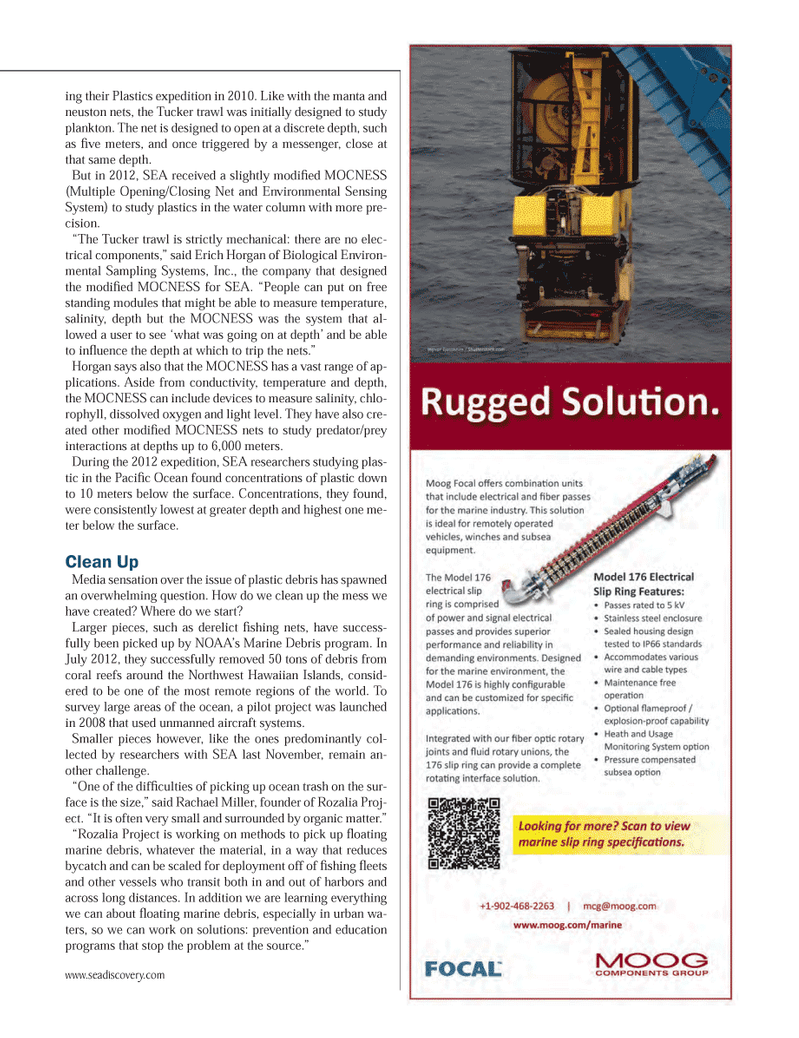
Page 17: of Marine Technology Magazine (January 2013)
Subsea Vehicle Report: Unmanned Underwater System
Read this page in Pdf, Flash or Html5 edition of January 2013 Marine Technology Magazine
ing their Plastics expedition in 2010. Like with the manta and neuston nets, the Tucker trawl was initially designed to study plankton. The net is designed to open at a discrete depth, such as Þ ve meters, and once triggered by a messenger, close at that same depth. But in 2012, SEA received a slightly modiÞ ed MOCNESS (Multiple Opening/Closing Net and Environmental Sensing System) to study plastics in the water column with more pre- cision. ÒThe Tucker trawl is strictly mechanical: there are no elec- trical components,Ó said Erich Horgan of Biological Environ- mental Sampling Systems, Inc., the company that designed the modiÞ ed MOCNESS for SEA. ÒPeople can put on free standing modules that might be able to measure temperature, salinity, depth but the MOCNESS was the system that al- lowed a user to see Ôwhat was going on at depthÕ and be able to inß uence the depth at which to trip the nets.Ó Horgan says also that the MOCNESS has a vast range of ap- plications. Aside from conductivity, temperature and depth, the MOCNESS can include devices to measure salinity, chlo- rophyll, dissolved oxygen and light level. They have also cre- ated other modiÞ ed MOCNESS nets to study predator/prey interactions at depths up to 6,000 meters.During the 2012 expedition, SEA researchers studying plas- tic in the PaciÞ c Ocean found concentrations of plastic down to 10 meters below the surface. Concentrations, they found, were consistently lowest at greater depth and highest one me- ter below the surface. Clean UpMedia sensation over the issue of plastic debris has spawned an overwhelming question. How do we clean up the mess we have created? Where do we start? Larger pieces, such as derelict Þ shing nets, have success- fully been picked up by NOAAÕs Marine Debris program. In July 2012, they successfully removed 50 tons of debris from coral reefs around the Northwest Hawaiian Islands, consid- ered to be one of the most remote regions of the world. To survey large areas of the ocean, a pilot project was launched in 2008 that used unmanned aircraft systems. Smaller pieces however, like the ones predominantly col- lected by researchers with SEA last November, remain an- other challenge.ÒOne of the difÞ culties of picking up ocean trash on the sur- face is the size,Ó said Rachael Miller, founder of Rozalia Proj- ect. ÒIt is often very small and surrounded by organic matter.Ó ÒRozalia Project is working on methods to pick up ß oating marine debris, whatever the material, in a way that reduces bycatch and can be scaled for deployment off of Þ shing ß eets and other vessels who transit both in and out of harbors and across long distances. In addition we are learning everything we can about ß oating marine debris, especially in urban wa- ters, so we can work on solutions: prevention and education programs that stop the problem at the source.Ó www.seadiscovery.com MTR #1 (1-17).indd 17MTR #1 (1-17).indd 171/28/2013 3:13:59 PM1/28/2013 3:13:59 PM

 16
16

 18
18
